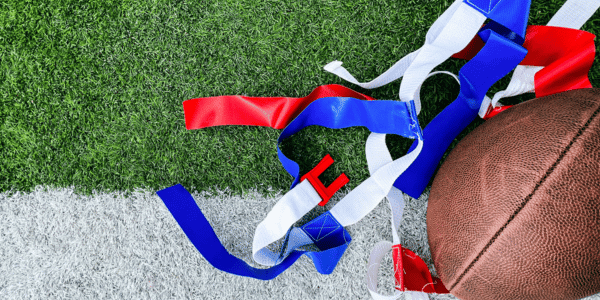How To Play Flag Football: What Beginners Need to Know

Every fall, football takes center stage. While tackle football reigns supreme, flag football is quickly gaining popularity, with enough recognition to now be an Olympic sport. Flag football introduces a twist to traditional football, creating a safer, speed-focused playing field. Learn how to play flag football and everything you need to know about flag football positions, rules, and more right here.
What is Flag Football?
Flag football is a variant of American football that reduces contact between players. Say goodbye to tackling – instead, defenders pull flags that hang from a belt on their opponents’ waistlines to stop play. Depending on the league, players will wear two or three flags around their waist.
The objective is the same as traditional football: earn the most points to win by advancing the ball to the end zone to score touchdowns. Without tackling, flag football is designed to be a fast-paced competition, with agility and elusiveness taking precedence over brute strength.
RELATED: How to Play Soccer: Basics, Rules, Positions, & More
Who Invented Flag Football?
Flag football’s origins date back to World War II. During the war, soldiers created the game as a form of recreation to avoid injuries and maintain their fitness. After the war ended, they brought it home, and it evolved into the sport we know today. Recreational leagues have been around since the 1950s. Now, multiple sanctioned leagues exist, including those in the National Football League’s (NFL’s) FLAG program and several youth programs.
About The Flag Football Field
Flag football fields are shorter than the ones you’ll see in college or the pros. Standard fields in NFL FLAG leagues are 70 yards long and 25 yards wide. There are still two end zones on either side of the field, but there are also “no run zones” just before the end zone and at midfield, forcing players to pass to get first downs or score touchdowns. The rest of the field is similar to tackle football, with yard markers throughout and a “line of scrimmage” wherever the ball is placed to separate the offense and defense before a play begins.
Flag Football Positions
There are five to nine players on each flag football team.
Offensive Flag Football Positions
- Quarterback: Passes the football, assessing the defense to put other players in a position to score. Unlike in tackle football, quarterbacks can’t run with the ball unless they hand it off, and it is then handed back to them.
- Wide receivers: Catch passes, evading defenders to avoid having their flag(s) pulled. There are usually two or three receivers on the field.
- Running back: Handed the ball in the backfield by the quarterback. They can also catch passes or protect receivers who catch passes. Tackle football running backs can use their strength to move up the field, but flag football backs must be fast to prevent being caught by defenders.
- Center: Snaps the ball to the quarterback. While their role traditionally requires them to protect other players, centers in flag football can also serve as pass catchers.
A set of defensive players counters these offensive players. Defensive roles are also reduced from the standard positions in flag football.

Defensive Flag Football Positions
- Defensive back: Defensive backs stand on opposite ends of the field, defending against runs and shorter passes.
- Safety: Playing behind the defensive backs, safeties prioritize defending passes further down the field. Often, the defensive quarterback leads the other players, telling them where to be on the field and what to look for in their competition.
- Rusher: Rushers specialize in pulling the flag off of the opposing team’s quarterback behind the line of scrimmage, the equivalent of a tackle football sack.
RELATED: Ice Breaker: How to Play Hockey
How to Play Flag Football
Flag football can be played in two halves or four quarters. The length of the game depends on the level of competition. Youth leagues have much shorter games than their college and professional counterparts. Advanced leagues typically play 20-minute halves or 10- to 15-minute quarters.
The game begins with a coin toss. The team that wins the coin toss can choose to start on offense or defense. The offense has four tries (called downs) to move the ball 10 or more yards forward until they reach their end zone.
Each attempt starts with players lined up opposite each other with the ball positioned between them, creating the line of scrimmage. When the offense successfully gains 10 or more yards, they get a new set of four downs. This continues until a team scores.
If one or more of a player’s flags are taken off while they have the ball, the play ends at the spot on the field, and the next down begins. In addition to pulling off flags, the defense can intercept the ball to gain possession and flip the roles of the two teams.
Flag Football Rules
A no-contact sport, flag football rules are different from tackle football. Here are the most notable changes:
- There are no fumbles. If one occurs, the play stops, and the offense retains possession of the ball at that spot.
- One or both of an offensive player’s flags can be pulled off to stop play.
- All passes must be forward.
- All handoffs must be direct.
- No blocking of offensive players is allowed. Instead, offensive players can “screen” defensive players, using their bodies to block them, but never initiate contact or use their hands.
- Defensive players must start plays seven yards from the line of scrimmage to give offensive players some room before their flag is potentially pulled.
The number of points awarded for each touchdown is the same as what you would see in the NFL or NCAA. However, in flag football, there are no kickers, so extra points are earned by another method.
RELATED: 14 Tailgating Hacks That Score
The Flag Football Scoring System
- Touchdown (6 points): When an offensive player runs or passes the ball into their end zone.
- Extra Point (1 point or 2 points): When a team completes a pass to the end zone from five yards away after they score one extra point. They can try from 10 yards away to earn two points.
- Safety (2 points): When a quarterback gets their flag pulled off in their own end zone.
Flag Football and Other Fun Fall Sports
Now that you know how to play flag football, take some time to learn about other games that are in-season. In our “Nothing But Net: Basketball Guide for Beginners,” we break down one of the most popular sports in the world. Use it to learn when and where basketball was invented, the positions on the court, and how the game changes across leagues!
How to Play Flag Football FAQs
Why do they call it flag football?
Flag football gets its name from the flags around every player’s waist during play. These flags are pulled off to stop players on offense instead of tackling them.
When is flag football season?
Flag football is played year-round, with the fall and spring seasons being the most common times for the game to be played.
How long is a flag football game?
Flag football can be played in two halves or four quarters. The length of the game depends on the level of competition, with youth leagues having much shorter games than their college and professional counterparts. Advanced leagues typically play 20-minute halves or 10-15-minute quarters.
Is flag football in the Olympics?
In October 2023, flag football was announced as an Olympic sport for the 2028 Summer Olympics in Los Angeles, California.
How many points is a touchdown worth in flag football?
A touchdown in flag football is worth six points. After a touchdown, teams can attempt to get an extra one or two points. Completing a pass to the end zone from five yards away earns one additional point. Completing a pass to the end zone from 10 yards away earns two points.


